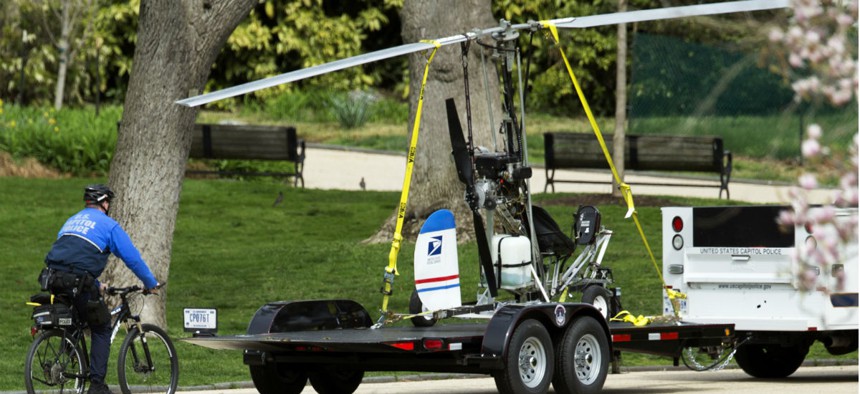Who Protects the Skies Over the Capitol?
Congressional airspace is guarded by a dizzying web of agencies—none of which stopped a gyrocopter from landing on the West Front.
A phalanx of Washington's top security officials will explain to the House Oversight and Government Reform Committee Wednesday just how a gyrocopter was able to land next to the Capitol—and who is ultimately in charge of protecting congressional airspace.
The agency directors will be six deep—the Secret Service and the Federal Aviation Administration heads, the Park Police and the Capitol Police chiefs, the House Sergeant at Arms, and the commander of NORAD. The witness list alone illustrates the wide and complicated web of jurisdiction governing the skies over the Capitol.
Committee Chairman Jason Chaffetz says he wants to get to the bottom of how exactly 61-year-old Doug Hughes was able to fly from Gettysburg, Pa., and through restricted airspace to land on the Capitol's west front lawn—and who knew what and by when. Answering those questions will require untangling the web of agencies charged with policing, monitoring, and defending that small slice of restricted airspace.
The growing use of small, manned planes and unmanned aircraft systems concerns the committee, as do the agencies' preventative measures.
"[These] are big, large agencies, but when you have minutes to respond, communication is key," Chaffetz told National Journal. "After 9/11, we better darn well have our act together."
The North American Aerospace Defense Command is in charge of preventing air attacks against the United States and Canada, which it does alongside law enforcement and Homeland Security. NORAD uses command centers to track planes in tandem with Federal Aviation Administration officials, Navy Capt. Jeff Davis, a NORAD spokesman, told National Journal. And it can defend the country when a plane comes in with the "intent to attack the nation," Davis said.
But when it comes to distinguishing a gyrocopter or a drone from a bird or a cloud or terrain, the difficulty increases. "We've been saying for some time detecting and tracking low, slow air threats is a technical and operational challenge," Davis said.
Finding a solution is a multi-player deal, and "the key is that we all work together and share information and respond together," Davis said. And this involves combining the prowess of the other agencies sitting at the witness table of Wednesday's committee hearing.
The Department of Homeland Security has a science and technology directorate that works with the public and private sector to help with security issues stemming from the rise of commercial unmanned aerial systems, according to a DHS spokeswoman.
The FAA is another piece of that puzzle, working closely with the Department of Defense and DHS as support for aviation-security missions. But the FAA also operates the nation's air-traffic-control system; manages the daily flow of planes and passengers; and ensures aircraft arrive safely at their destination, according to an emailed agency statement.
Then there's the law enforcement agency charged with policing the congressional campus every day. And in the days following the gyrocopter incident, Capitol Police Chief Kim Dine met with multiple lawmakers who oversee the department to answer their questions on just what happened April 15.
Typically, when an aircraft comes within the restricted airspace around the building, the Capitol Police Board—made up of the House and Senate Sergeant at Arms and the Architect of the Capitol—is notified. The board will monitor the situation as it unfolds, receive updates from the Capitol Police Command Center, and be available if campus decisions need to be made or orders need to be given to the Capitol Police.
That's a challenge, said Rep. Candice Miller, who chairs the House Administration Committee charged with overseeing the chamber's security. "It's a very difficult wiring diagram because I think whoever is the chief is not quite sure who they report to," Miller told National Journal.
The myriad agencies involved—and their bureaucracy—further complicate an already complex decision when an intruder flies through restricted airspace. "You have 32 different agencies with some degree of law enforcement responsibly in the Capitol region," Chaffetz said. "The question about airspace is a complicated one. That's why we have to have so many people testify."




